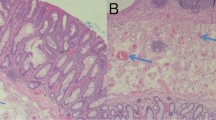Abstract
Background
Hereditary hemorrhagic telangiectasia (HHT) (the Osler–Weber–Rendu syndrome) is a rare autosomal dominant disease characterized by telangiectasias and arteriovenous malformations of the upper and lower respiratory tract, gastrointestinal tract, skin and central nervous system. Several previous reports have documented the appearance of a concomitant neoplasm in patients with this syndrome.
Aims
To study the occurrence and the clinical characterization of colonic neoplasm in patients with HHT.
Methods
We retrospectively reviewed the computerized database of the Hadassah University Hospitals (Jerusalem, Israel) for all patients with the diagnosis of HHT between January 1st, 1980 and July 30th, 2002. Cases of neoplasm were documented by review of medical charts and pathology reports.
Results
Six of the 24 patients developed malignancy. Three of the cases had extra colonic malignancy (melanoma in two patients and adenocarcinoma of urinary bladder in one patient) and three patients had adenocarcinoma of the colon. An additional three patients developed multiple colonic polyps (one patient had melanoma and one patient had adenocarcinoma of urinary bladder).
Conclusions
HHT may be associated with the development of colonic adenocarcinoma and polyps. Therefore, in patients with HHT who present with new-onset anemia or gastrointestinal bleeding a lower gastrointestinal tract evaluation should be performed, even if their blood loss is suspected to be a manifestation of gastrointestinal HHT.
Similar content being viewed by others
References
Guttmacher AE, Marchuk DA, White RI (1995) Hereditary hemorrhagic telangiectasia—review. N Engl J Med 333:918–924
Shovlin CL, Letarte M (1999) Hereditary haemorrhagic telangiectasia and pulmonary arteriovenous malformations: issues in clinical management and review of pathogenic mechanisms. Thorax 54:714–729
McAllister KA, Grogg KM, Johnson DW et al (1994) Endoglin, a TGF-β binding protein of endothelial cells, is the gene for hereditary hemorrhagic telangiectasia type 1. Nat Genet 8:345–351
Johnson DW, Berg JN, Baldwin MA et al (1996) Mutations in the activin receptor-like kinase 1 gene in hereditary haemorrhagic telangiectasia type 2. Nat Genet 13:189–195
Piantanida M, Buscarini E, Dellavecchia C et al (1996) Hereditary haemorrhagic telangiectasia with extensive liver involvement is not caused by either HHT1 or HHT2. Med Genet 33:441–443
Wallace GMF, Shovlin CL (2000) A hereditary haemorrhagic telangiectasia family with pulmonary involvement is unlinked to the known HHT genes, endoglin and ALK-1. Thorax 55:685–690
Jameson CF (1989) Primary hepatocellular carcinoma in hereditary haemorrhagic telangiectasia: a case report and literature review. Histopathology 15:550–551
Sussman EB, Stephen MD, Sternberg MD (1975) Hereditary hemorrhagic telangiectasia—a case with hepatocellular carcinoma and acquired hepatocerebral degeneration. Arch Pathol 99:95–100
Breuninger H, Bogenschurz O, Konrad E et al (1997) Teleangiectasia haemorrhagica hereditaria (Osler–Weber–Rendu disease). Surgical therapy of malignant skin tumors. Hautarzt 48:496–499
Kato S, Ichiara K (1988) Hereditary hemorrhagic telangiectasia with malignant lymphoma. An autopsy case. Acta Pathol Jpn 38:383–391
Livandovskii IuA, Listratov Sia, Naumova GA (1975) Rare case of association of Rendu–Osler disease with lymphocytic leukemia. Klin Med (Mosk) 53:118–119
Patakfalvi A, Marton E (1974) Simultaneous occurrence of Osler–Weber disease and IgA myeloma with severe antibody deficiency syndrome. Orv Hetil 115:1287–1289
Gemke GR, Kaupasa MM, Rafalskii AA et al (1994) Association of Rendu–Osler disease, polyarthritis and ovarian cancer. Klin Med (Mosk) 72:65–66
Goldman K, De Pietro WP (1989) A case of adenocarcinoma of the colon in a patient with hereditary hemorrhagic telangiectasis. Cutis 43:371–372
Hisamura M, Akita K, Ide H (1994) A case of Rendu–Osler–Weber disease associated with simultaneous, multiple advanced cancers in the colon. Hokkaido Igaku Zasshi 69:1468–1475
Conte WJ, Rotter JI, Schwartz AG et al (1982) Hereditary generalized juvenile polyposis, arteriovenous malformations and colonic carcinoma (Abstract). Clin Res 30:93A
Baert AL, Casteels-Van Daele M, Broeckx J et al (1983) Generalized juvenile polyposis with pulmonary arteriovenous malformations and hypertrophic osteoarthropathy. Am J Roentgenol 141:661–662
Cox KL, Frates RC, Wong A et al (1980) Hereditary generalized juvenile polyposis associated with pulmonary arteriovenous malformation. Gastroenterology 78:1566–1570
Radin DR (1994) Hereditary generalized juvenile polyposis: association with arteriovenous malformations and risk of malignancy. Abdom Imaging 19:140–142
Prieto G, Polanco JS, Larrauri J et al (1990) Association of juvenile adenomatous polyposis with pulmonary arteriovenous malformation and hypertrophic osteoarthropathy. J Pediatr Gastroenterol Nutr 11:133–137
Gillespie JS, McIvor RA (2001) Hereditary hemorrhagic telangiectasia in association with generalized juvenile polyposis. Ulster Med J 70:145–148
Ballauff A, Koletzko S (1999) Hereditary hemorrhagic telangiectasia with juvenile polyposis-coincidence or linked autosomal dominant inheritance? Z Gastroenterol 37:385–388
Schumacher B, Frieling T, Borchard F et al (1994) Hereditary hemorrhagic telangiectasia associated with multiple pulmonary arteriovenous malformations and juvenile polyposis. Z Gastroenterol 32:105–108
Inoue S, Matsumoto T, Iida M et al (1999) Juvenile polyposis occurring in hereditary hemorrhagic telangiectasia. Am J Med Sci 317:59–62
Boardman LA, Thibodeau SN, Schaid DJ et al (1998) Increased risk for cancer in patients with the Peutz-Jeghers syndrome. Ann Intern Med 128:896–899
Giardiello FM, Welsh SB, Hamilton SR et al (1987) Increased risk of cancer in the Peutz-Jeghers syndrome. N Engl J Med 316:1511–1514
Lynch HT, Smyrk T, Lynch J (1996) Hereditary non-polyposis colorectal cancer (Lynch syndrome). An updated review. Cancer 78:1149–1167
Gilchrist DM (1997) Hereditary colon cancer. Can J Gastroenterol 11:421–423
Coburn MC, Pricolo VE, DeLuca FG et al (1995) Malignant potential in intestinal juvenile polyposis syndromes. Ann Surg Oncol 2:385–391
Plauchu H, De Chadarevian JP, Bideau A et al (1989) Age-related clinical profile of hereditary hemorrhagic telangiectasia in an epidemiologically recruited population. Am J Med Genet 32:291–297
SEER Program (1999) SEER cancer statistics review: 1990–1999. National Cancer Institute, Bethesda, MD. Seer cancer.gov
Author information
Authors and Affiliations
Corresponding author
Rights and permissions
About this article
Cite this article
Elinav, E., Salameh-Giryes, S., Ackerman, Z. et al. Does any lower gastrointestinal bleeding in patients suffering from hereditary hemorrhagic telangiectasia (Osler–Weber–Rendu) necessitate a full colonic visualization?. Int J Colorectal Dis 19, 595–598 (2004). https://doi.org/10.1007/s00384-004-0607-3
Accepted:
Published:
Issue Date:
DOI: https://doi.org/10.1007/s00384-004-0607-3




